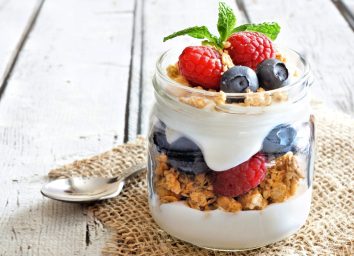I Tried the 6 Healthiest Greek Yogurts & The Best Was Pure, Lush and Creamy
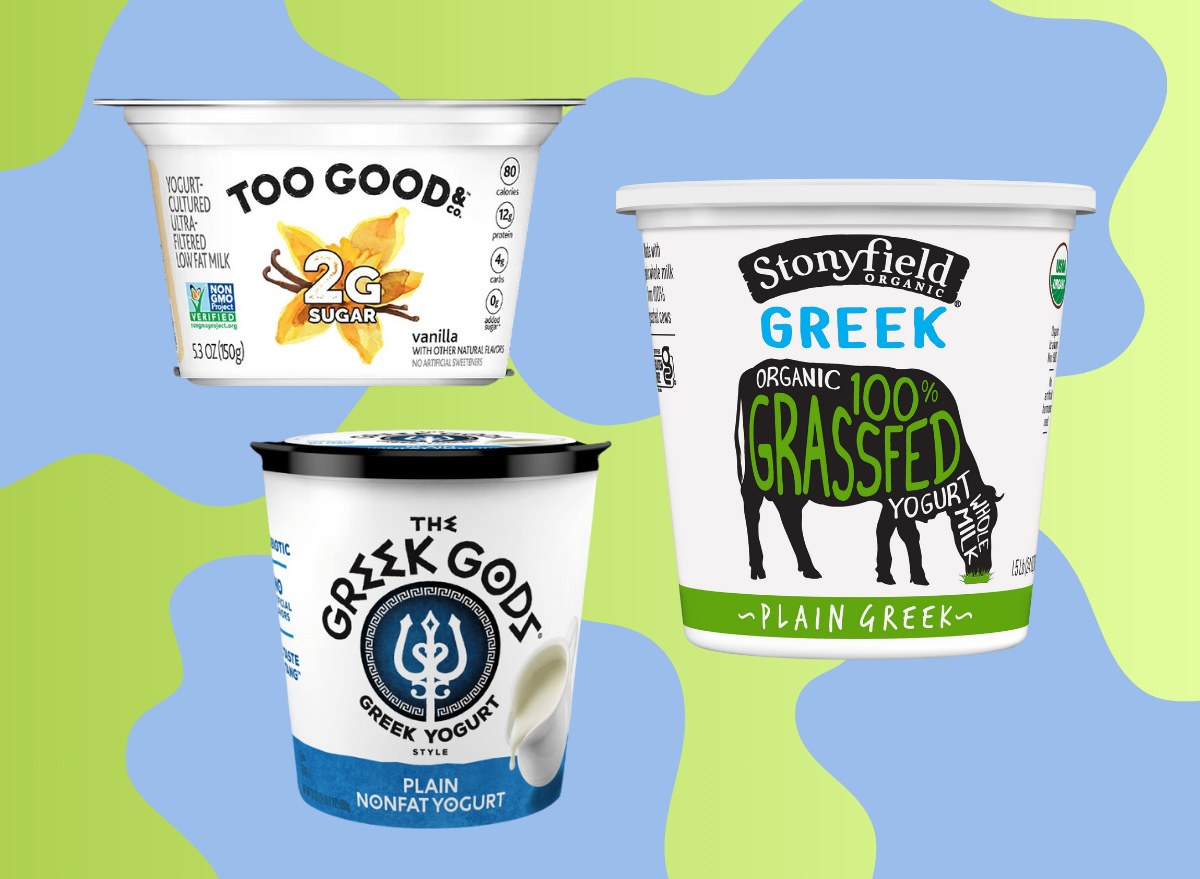
With more varieties of Greek yogurts in the dairy case than you can shake a bag of granola at, it’s easy to get decision paralysis while surveying the options at the grocery store.
From whole milk to nonfat and plain versus flavored, it can be tough to decide which one to buy. It’s difficult to swap from one brand to another when texture, fat, and even ingredients fluctuate wildly between them. It’s harder still with “Greek-style” yogurts infiltrating the shelves between the real-deal thick-strained types. Even within the same brand, going from one line or fat percentage to another can lead to significant differences in taste and mouthfeel.
Then, when you add vanilla to the mix, more wild cards emerge. Different types and quantities of sweeteners, extracts, and natural flavors are all specific to each brand’s yogurt formula, leading to the broadest of interpretations. What’s sweet to one brand is considered low sugar for another, and a low-sugar recipe using a different type of sweetener, like sucralose versus stevia, can also lead to an amplified sweetness perception. To some, vanilla means birthday cake; to others, it means milkshake.
So, how can you choose the right healthy Greek yogurt that also tastes great? We previously asked dietitians to analyze the nutritional profiles of various popular options to identify the healthiest Greek yogurts available, and now, we’re following up with a taste test of each to help you decide which gut-healthy snack is also the right fit for your palate.
Here’s how each of the six RD-approved Greek yogurts compare based on taste, and ranked in descending order from worst to first.
The Greek Gods Plain Nonfat Yogurt
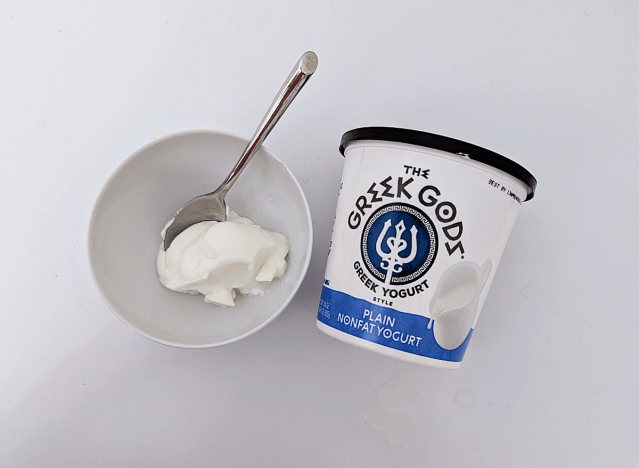
Calories: 100
Fat: 0 g (Saturated Fat: 0 g)
Sodium: 140 mg
Carbs: 14 g (Fiber: 0 g, Sugar: 12 g)
Protein: 10 g
Admittedly, the Greek Gods don’t technically make Greek yogurt; its products are Greek-style. That’s because instead of using the traditional straining method that defines that type of yogurt, the Greek Gods make it in a traditional manner and add pectin to thicken it up. That’s also why the brand’s protein counts are lower, and the ingredient list is longer. However, that’s also why this brand can boast of a lack of tang if tang’s not your jam. I picked up a 24-ounce container of the brand’s plain nonfat yogurt at Sprouts Farmers Market for $4.99.
The look: Under a tightly sealed, printed plastic lid and plain foil was a solid pressed cake of slightly graying, off-puttingly shiny yogurt haloed in liquid with a slight yellow cast. When I scooped out the testing portion, there was an audible squelching sound as the spoon sliced clean through, like silken tofu with the jiggliness of canned cranberry sauce. Once it hit the bowl, the liquid separation became more apparent, with small chunks floating in it. The mass of it, though, was disturbingly smooth and oddly unappealing.
The taste: The Greek gods are known for their cruel jokes, but calling this a Greek yogurt might go too far. I’m a good eater. I like most things and love yogurt, but this was—and I don’t say this lightly—disgusting. I had to all but hand-whisk it vigorously to make it yogurt-shaped, and even so, my spoonful plopped gloppily in my mouth, and I needed to smush it down with my tongue while eating it. While there was no tang, per the brand’s big promise, there was other unpleasantness going on that made me wish I had some distraction. A blubbery, unflavored gelatin taste and feel, for one, that felt hollow like it was missing something critical, and an undertone that brings to mind mild farmer’s cheese but without the real-food texture. I didn’t want to take a second bite, but I wanted to be fair. But no, the first impression was correct. This was objectively just not good.
Chobani Zero Sugar Vanilla
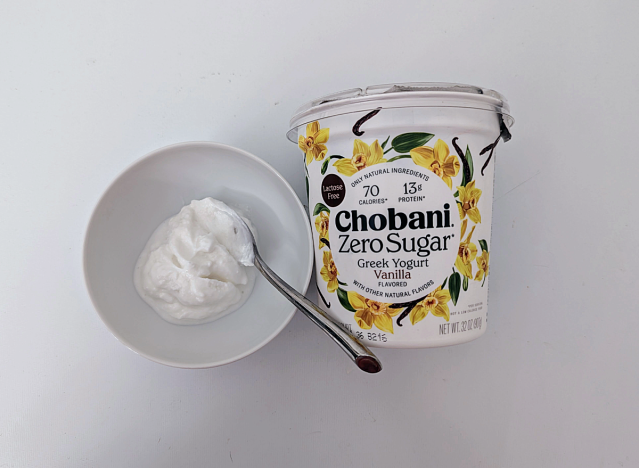
Calories: 70
Fat: 0 g (Saturated Fat: 0 g)
Sodium: 70 mg
Carbs: 6 g (Fiber: 1 g, Sugar: 0 g)
Protein: 13 g
The top-selling brand in the U.S., the New York-originated brand Chobani has become synonymous with Greek yogurt, dominating dairy cases nationwide. Its various lines include the decadent dessert-inspired Flip, the new Creations, and the health-conscious Less Sugar and Zero Sugar collections. Choosing from within this brand isn’t easy. Luckily, our dietitians did, opting for this version that uses ultra-filtered nonfat and regular skim milk for a lactose-free formula, three types of natural but non-sugar sweeteners, and plant-based thickeners that pull back the calorie count of classic strained. A 32-ounce container cost $5.99 at Publix.
The look: A clear plastic top that loosely floats over the thick printed foil lid protects a bright white yogurt on the watery side with a visible whey separation. It presented a bit gloopy and runny in turns, and little chunks of curd were visible, leading me to anticipate some graininess as it didn’t look smooth. It was the runniest of all of them and the grittiest-looking, which is interesting since it has the most variety of thickeners of all six.
The taste: Sweet, light, and a little floral, this vanilla yogurt was closer to marshmallow fluff than frosting, with a hint of artificial sweetener that doesn’t hit you upside the head. The allulose used has a higher note of sweetness that immediately dances across the tongue but fades into neutrality. Perhaps it’s because the more aerated texture breaks up the concentration of the flavors that it doesn’t ever feel like the taste sensations ever expand and coat the mouth. Or maybe the texture boosters make the flavors less dense, but it’s fairly innocuous. After a while, it starts tasting a little weird, though—less vanilla and more marshmallow as time passes.
Two Good Vanilla
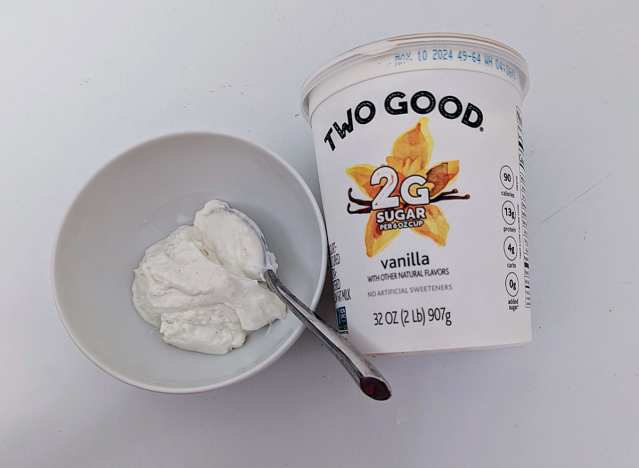
Calories: 90
Fat: 2 g (Saturated Fat: 1 g)
Sodium: 40 mg
Carbs: 4 g (Fiber: 0 g, Sugar: 2 g)
Protein: 13 g
While our dietitians recommend the plain variety of this brand, it’s a challenge to find it in stores, so I tested the vanilla. Both are thickened with additives, making them Greek-style only. It offers two strains of live and active cultures. The good news is that it has just as little sugar, only one more gram of carbs, 10 milligrams of sodium, and one gram less protein for the same serving size. The company donates to organizations that aid Americans in need while combating food waste. A 32-ounce container cost $7.09 at Publix.
The look: Packaged with a tight-fitting lid and a slightly thinner printed foil top that unfortunately ripped. The yogurt within was a creamy off-white instead of the brilliant white of the other vanilla flavors, with visible dark specks of vanilla bean, giving it distinctly dessert-like ice cream vibes. The body had some slight curds and graininess, but that stirred out easily, especially since there was barely any whey run-off to fold back in.
The taste: Also light and sweet, this gave elegant white cake with vanilla vibes and was much more dessert-like than the Oikos Triple Zero, tested below. The texture is rather fluffy with tiny, grain-sized crunchy bits of sweetener or vanilla bean to break up the buoyancy lent by using tapioca starch and gellan gum as thickeners. This gives it a mouthfeel between Greek yogurt’s natural thickness and regular yogurt’s looser structure. Refreshing and lovely, it was easy to eat a lot of this, especially since there’s only a hint of tang in the aftertaste, slightly sour on the tongue while your other taste buds hold onto the sweetness of stevia.
Oikos Triple Zero Vanilla
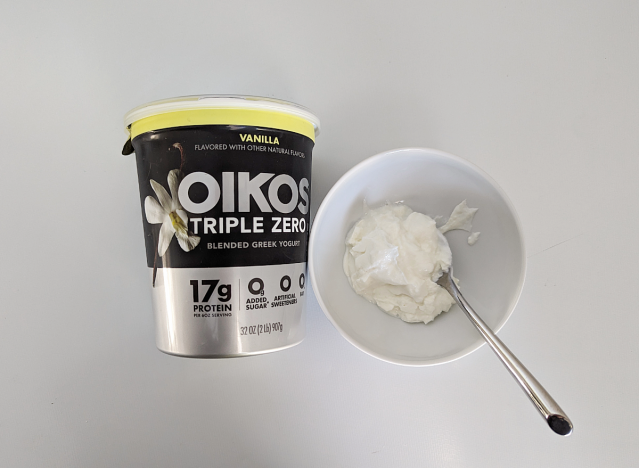
Calories: 100
Fat: 0 g (Saturated Fat: 0 g)
Sodium: 65 mg
Carbs: 8 g (Fiber: 0 g, Sugar: 6 g)
Protein: 17 g
The Oikos Triple Zero line of Greek yogurt is owned by Dannon, a classic company that has been serving creamy yogurty goodness since 1942. It’s also beloved by the gym community. A strong, powerful image with a high-protein promise and no added sugars, artificial sweeteners, or fat across the line, this leads the (fridge) pack in a collection that also includes Oikos Pro with ultra-filtered milk and added whey, Oikos Blended, and Oikos Remix with toppings. Its scant handful of ingredients discloses less than 1% of tapioca starch and stevia, but on the downside, like Two Good, which is also a Dannon brand, it only contains two types of live and active cultures. A 32-ounce container of this yogurt cost $5.99 at Lidl.
The look: Pulling off the clear plastic top, which fit nice and tight across the container, then the thick printed foil cover revealed a yogurt that was dazzlingly white and looked smooth, creamy, and thick. It was poured in evenly and presented perfectly settled and level with tiny curds and barely any liquid separation.
The taste: This was the smoothest flavored Greek or Greek-style yogurt of the entire bunch, mildly sweet with a mild tang, creating a flavor balance that was incredibly harmonious and well-blended. Every spoonful went down with effortless ease and consistent flavor and feel throughout. Its thick and creamy texture feels more natural than others with additives, probably because it is. It has to have more dairy to achieve that protein level. Because it is sweetened with stevia, there is a bit of a sweet afternote, but it dissipates fairly quickly. This would fit firmly under True Neutral on a moral alignment chart: inoffensive, generally pleasing, and unlikely to ruffle feathers. In other words, it’s plain vanilla at its best—good but not boring, with the singular purpose of providing nutrition that isn’t tedious.
Stonyfield Organic 100% Grassfed Whole Milk Yogurt, Plain Greek
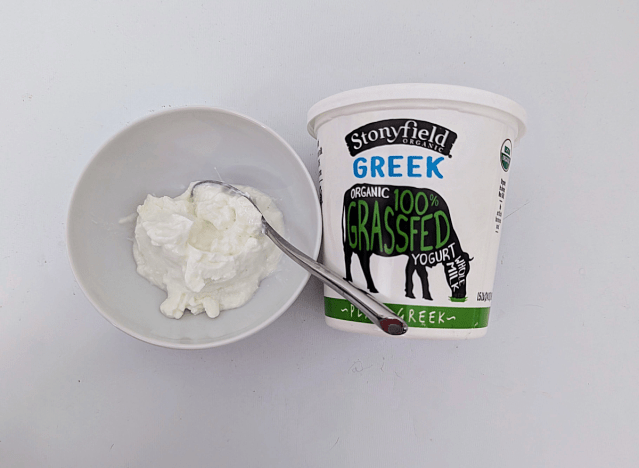
Calories: 150
Fat: 6 g (Saturated Fat: 3.5 g)
Sodium: 65 mg
Carbs: 7 g (Fiber: 0 g, Sugar: 5 g)
Protein: 16 g
Like Two Good’s Plain flavor, the 100% Grassfed version of this brand’s Greek yogurt is also not readily available across stores. The good news is that it’s pretty reliably found in the higher-end “natural” markets, and (spoiler alert!) it’s worth the extra cost and effort. The whole organic milk used comes from pasture-raised cows fed with pesticide-free grass only, and its two-ingredient list is even more impressive for how many billions of happy little probiotics are dancing in this high-protein dairy product. A 24-ounce container cost me $8.49 at Sprouts.
The look: Like many others, a tight plastic printed lid acts as the yogurt’s first defense for freshness, but a departure from the norm is a clear plastic inner seal instead of aluminum foil. Once you pull that off, it’s apparent that it’s a warmer cream color than the others—which makes sense since grass-fed butter is often more yellow. This isn’t as dramatic a difference, but it’s noticeable in a lineup. There’s a little wateriness and some visible curds, but only if we’re being exceedingly nitpicky.
The taste: Grass-fed milk and butter taste different. It quickly became apparent that the same goes for yogurt. A few loose stirs and it sprang to life, lusciously and appetizingly creamy-looking. And the first bite was even better than it looked.
My first thought was, “Mmm, buttery!” followed by a very strong but smoothly transitioning tang, draping over my tongue like a cape on my shoulders. It tasted like sunshine and cream dancing together before switching positions with a deep sour note and savory sensation. It then came back to a creamy richness as the full fattiness coated every corner of my mouth. It woke my palate up with a feeling of sumptuousness that felt as plush as a cream sauce. Even the small, drier chunks broke down easily and rapidly melted away, like how a ribeye’s marbling soaks into the meat. One bite and I immediately wanted another and another.
Fage Total 5%
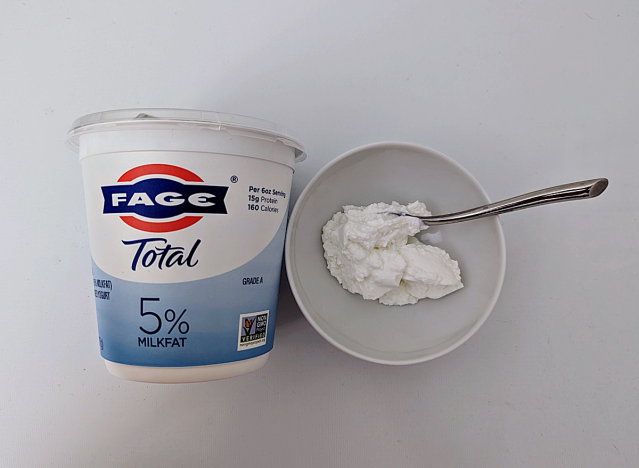
Calories: 140
Fat: 8 g (Saturated Fat: 5 g)
Sodium: 55 mg
Carbs: 5 g (Fiber: 0 g, Sugar: 5 g)
Protein: 14 g
The number-one brand in Greece, Fage is also the label you can thank for the breadth of yogurt selection now available in the U.S. Introduced here in 1998, it already has a great reputation in its homeland of Greece, the U.K., and Italy. Today, it continues to follow the family recipe that dates back to 1926 and maintains a three-ingredient list of milk, cream, and cultures—never thickeners nor preservatives—to create its protein-dense treat. A 32-ounce container of this yogurt cost $6.89 at Publix.
The look: Like Chobani’s quarts, the printed thick foil wrap is protected by a bubbled-up, rounded-edge lid. But unlike any others, there’s also a round of parchment paper over the yogurt (that many don’t know is supposed to be removed after opening). This is to absorb secreted whey while the yogurt settles in transit. But once it’s home, you can throw it away as you dig into a bright white Greek yogurt that’s exceptionally thick and full-looking, with the peaks, dips, and—upon spooning—snowball curds that look like voluminous but heavy hand-whipped cream.
The taste: This yogurt requires only a very shallow stir; it rises in crags otherwise, again, just like whipped cream. But that’s only where that particular comparison begins! It tasted mild at initial contact, then gently, gently crept the tang, sharp and slow-moving, staying with me longer than Stonyfield’s, even after several eager re-tastes.
However, that sharpness was still a brief moment. The lasting impression was one of balance as a subtle sweetness and full-bodied, mature richness swept in and flooded my mouth with a fresh, clean dairy taste that tasted impossibly pure while maintaining lushness. Essentially, this is thick, heavy whipped cream with some sass.
Why is this the favorite? Choosing between the savory flavor and deeper tang of the Stonyfield Organic 100% Grassfed Whole Milk Yogurt, Plain Greek, and the sweetness and higher octave tang of the Fage Total 5% was tough. It’s a draw that ultimately comes down to preference of depth. But after happily going back and forth between the two, the Fage won me over. To reevaluate where this whole taste test began, this one is a gift from the true Greek gods—Greek yogurt as the Greeks intended.


